Hi Luck Hackers,
Today, I want to discuss an essential leadership skill that can make or break your career or your company.
It’s a story we’ve all seen before. A qualified candidate is ready to be promoted, but it never seems to happen. They never seem to make it to the top.
The thing is that many potential leaders spend most of their career on the day-to-day operational tasks, tackling tactical challenges and dealing with interpersonal issues.
And many excel at getting projects done on time, resolving problems, and even dealing with significant HR issues.
It’s easy to assume that mastering these skills will lead to higher positions in the organization, promotions, and greater success.
But here’s the catch, that’s not how it works.
Over the course of my career, I’ve worked with leaders, executives, and professionals in hundreds of companies, ranging from people in startups to some of the world’s biggest companies.
I’ve been a partner at the Boston Consulting Group, where I help some of the world’s most important companies with issues of strategy and performance. And while I was at BCG, I was also responsible for a lot of the hiring and career development, which gave me a front row seat into this issue of professional development.
I’ve also personally been a CEO and experienced the issues, struggles, and challenges of being a CEO.
And I’ve seen the benefits of this skill firsthand, both in my consulting career, in the companies I’ve worked with, and in the companies I’ve run.
I’ve seen how important this skill is and what happens when people fail to develop it.
So, I wanted to understand why people struggle so much with this key skill.
What’s the challenge, and how can you tackle that problem?
Things can be very confusing when you’re not getting promoted, struggling to reach the next level, or even struggling at the next level.
What makes it super frustrating for people is that what they’re being told is one thing, but what they’re experiencing is often quite different.
They’re told by the decision-makers that the most important factors are things like inspiring and motivating others. Honesty, integrity, being good at solving problems, being good at resolving issues, being good at delivering results. And those were all critical factors to being successful as a manager. But they are, in a sense, table stakes for being a strategic leader.
To understand this better, I started investigating and found some fascinating research.
These researchers ignored what the decision-makers were saying and looked at their behaviors.
Who did they rank as a high-potential candidate? Who did they promote? And what skills seemed to make the most difference?
They looked at about 20 different skills and focused on what correlates with being rated as a high performer and getting promoted.
They found the single crucial skill that some executives have and people who want to be successful executives need to have.
In this chart, you get to see some of the research that they produced.
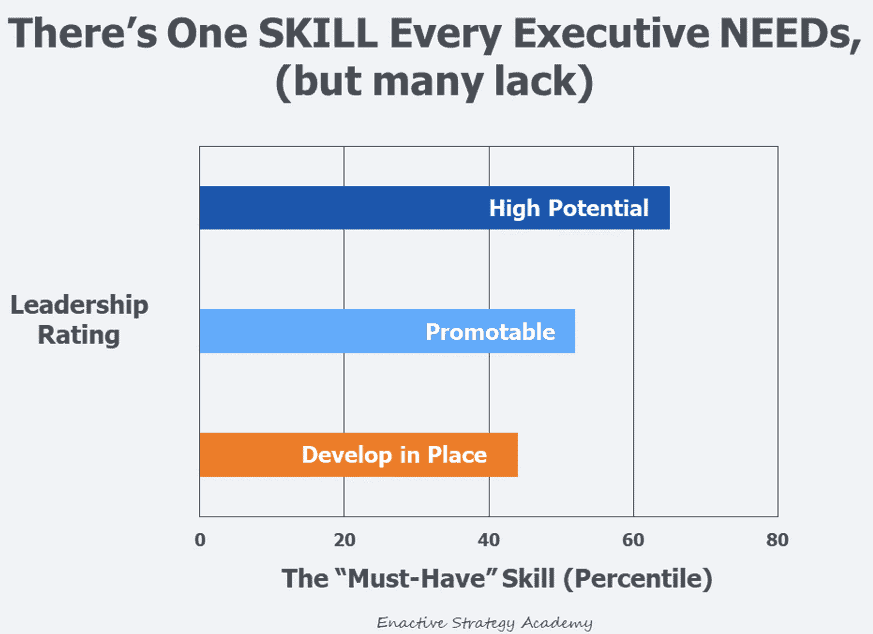
You see that high-potential people were rated much higher on this skill. This skill was found to be the differentiating factor that separated successful executives from the also-rans.
And this skill also has a significant impact on how well executives perform once they’ve been promoted.
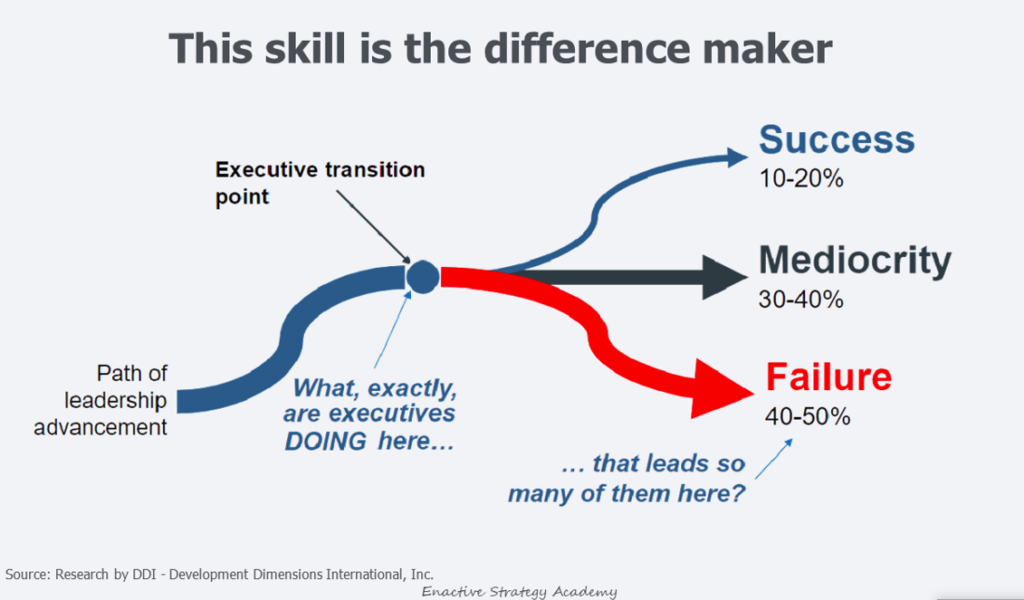
When you look at what happens when someone gets promoted, there’s something that happens.
There’s this transition point that changes the course of their career.
They found that many executives fail when they reach the next level because they haven’t developed this skill, invested in it enough, or mastered it early enough in their careers.
In this edition of Luck Hacker, I’m going to dive into this skill, explain why it’s so important, what it is, and how you can start to master the skill.
But before I dive into this, I want to share one key observation that I’ve seen time and time again: the people who will read this newsletter all the way through, in a sense, are already committed to developing the skill.
This is not a skill you’re going to develop by buying a book in a store and putting it on the shelf, hoping it will magically improve you.
It’s not a skill that you can instantly turn on or turn off.
This is a skill that takes time and effort to master.
And the people who understand the importance of this skill are already taking action.
They are already investing in themselves, and they have the discipline to go through a newsletter like this and start putting these ideas into practice.
But people who lack the skill or don’t understand it tend to underinvest in its long-term development.
They try to treat it like they treat operations. You know, until it’s an issue, I won’t deal with it.
This is something that’s going to take time; mastery takes time.
And it’s important to understand how mastery works because it takes consistent and committed effort.
You would never think of being a great artist or a skilled athlete playing at a professional level without putting in the effort and deliberate practice required, without getting good coaching, without getting good training, without developing the skill over time.
You realize this is not something you can turn on or off. It’s something that you need to develop, something that becomes part of who you are and how you work.
And what you’d like to see is that this skill becomes a habit that continuously influences your behavior.
So the question you have to ask yourself is: are you willing to put in the effort it takes to succeed, or are you going to be somebody who observes and watches other people succeed?
Because if you’re willing to act, if you’re willing to move and make an investment in yourself, this will be one of the best investments you’ll ever make.
Now, let’s talk briefly about the dynamics behind this and what’s happening.
What you see is that people are being overlooked for roles that they think they deserve, and in fact, the problem is that they don’t have this necessary skill, so what ends up happening is that they miss out on opportunities.
They miss out on meaningful work, key projects, and promotions.
And this has a two-fold impact.
One is that it shortchanges them in terms of getting the experience they need to develop this skill.
And it also means they’re not getting opportunities to showcase their skills.
So, the missed opportunities hurt their performance.
And I see people responding to this in one of three ways.
- One way they respond is to check out. That’s what some people do. They take a victim mentality, and they decide that the world has happened to them, and they can’t do anything about it.
- The second group compensates by trying to work harder. They try and say, if I work harder at what I’m doing, I will get better results. But working harder at something will not change how you’re perceived in the organization. All it does is reinforce what you’re good at and reinforce people’s perceptions that you’re good at doing what you’re good at. But it doesn’t change their minds or help them see you in a new light.
- The third group takes charge of their destiny and decides to master this skill. They choose to invest in themselves, find ways to learn this skill, and find people who can mentor and coach them in this skill.
What the research shows is that something like 5 or 10 percent of people have mastered this skill. So you’re just not going to find this skill inside the organization. And because the organizations don’t understand the skill very well, they don’t know how to train you in the skill.
It’s something you need to take responsibility for.
You need to take charge of your own destiny. And find ways to invest independently of whatever the company is willing to do for you.
Because the only way you’ll master this skill is to find ways to invest in yourself.
And what happens when you start to master this skill is that you start to be seen as somebody who has more potential. As somebody who has increased leadership capacity.
And then you start to get more opportunities.
You will get better jobs. You will get better projects.
You will be given more opportunities because the organization will seek you out because you have this capability.
And that this ends up being a self-reinforcing cycle.
It becomes a system where the experience allows you to become better at this, which then allows you to get more opportunities, which gives you more experience, which again, allows you to become better at this.
So, it ends up becoming a very positive, virtuous cycle.
It becomes self-reinforcing because you’ve invested in it, and you start to see the returns on your investment.
Now that we’ve talked about why this skill is so important and some of the dynamics that go on inside organizations about why it’s so hard to learn, let’s talk about what this skill is.
I’ll go into that in some depth here because I think understanding it and having a nuanced view of it will help you understand how you can improve this skill.
What you’ll see this skill most commonly called is something like strategic thinking, strategic perspective, or strategic vision, or some words like that.
That’s how it’s characterized.
However, this framing doesn’t help you very much because you could become a better strategic thinker, but it wouldn’t necessarily change people’s perceptions because people can’t see what’s happening in your mind.
People can’t see how you are thinking. What people notice is your behavior.
They infer your thinking from your behavior.
They see the way you act, the way you interact, and the way you present yourself to the world.
So, these behaviors become much more critical.
What people want to see is you being strategic.
To perceive you as strategic, they need to see you being strategic.
In other words, you need to be somebody who is happening to this world.
I call this Enactive Strategy, the coupling of strategic thinking and strategic thought with intentional action where you are actively working to change the world.
And when you do this well, it can have a massive impact.
The effort that produces results at one level can be 100 times more impactful by leveraging the skill through better behaviors and better action.
So, I would like you to understand this enactive strategy idea more deeply.
But before I explain that more, I want to talk about the path to mastery and discuss some of the common problems and reasons why people struggle to develop this skill.
The first one is that organizations are not rich in this kind of skill. They don’t have much depth in this skill, and as a result, you get a lot of inadequate feedback, a lot of inadequate advice, and a lot of inadequate training.
You get a bunch of platitudes.
You’ll be told to think big picture; you’ll be told to think long term, to develop more vision.
These platitudes are not helpful.
But this is the advice you get, and it becomes impossible to do something productive with these platitudes.
They don’t inform you very effectively.
The second thing that you see is confusion between planning and strategy. The dominant understanding of strategy in many organizations is based on the way they do the strategic planning process, which is about 99% planning and probably 1% strategy.
Organizations don’t realize that strategy is different than planning.
A plan is not a strategy. A strategy is not a plan.
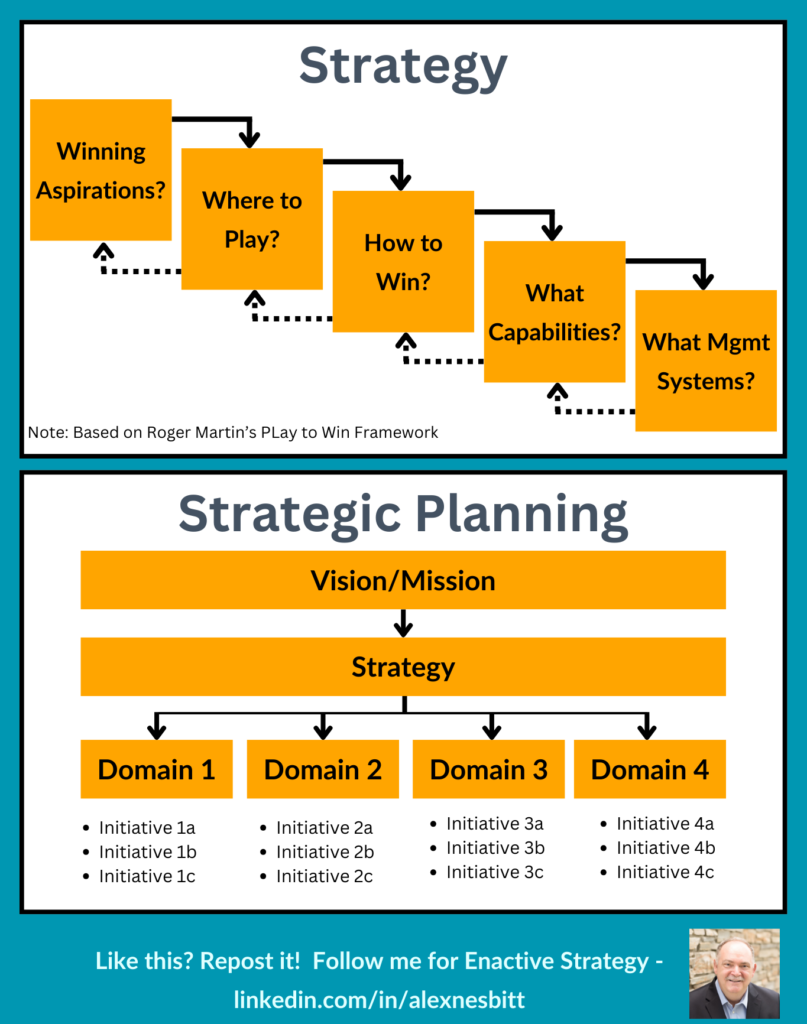
A strategic plan is a plan that reflects a strategy.
Strategy is something different, something separate from the plan itself.
Planning is an important element in thinking about strategy and strategic thinking. But when we try and become better at planning, we don’t necessarily become better at strategy.
So, this misconception tends to lead you down a path of trying to get better at planning when it’s not going to help you become a better strategist. It’s not going to help you think more strategically.
The third big problem is what I call the linear model of strategy. You’ll find it in books and academics.
Because what they’re doing in the books and in school is essentially trying to take this messy process and turn it into something that looks linear and like a step-by-step process, like a paint-by-numbers kind of approach.
What this misses is that strategy development is a nonlinear process.
It is something where you jump forward and backward. You develop prototypes that you explore, and then you learn from them, and you take that learning, and you develop a new prototype.
It’s a very iterative, hypothesis-driven process of strategic thinking.
And when you get told to follow five or seven or however many steps in terms of some strategy process, you’re just not going to get good results. You’re not going to become a better strategic thinker.
You need to be able to see the skill in action.
You need to be able to watch people work this skill and see how they go through this messy process of developing strategy, developing strategic thought, and then translating that thought into action.
Mastering the skill takes deliberate practice. It takes good feedback. It takes work. It takes time to develop this skill.
So, in terms of helping you with this, I try to take this perspective in my writing and teaching: If you were working for me, what skills would I want you to have? How can I help you think differently and behave in more strategic ways and have more impact on the world?
And what I’ve boiled this down into is five key pillars for being strategic.
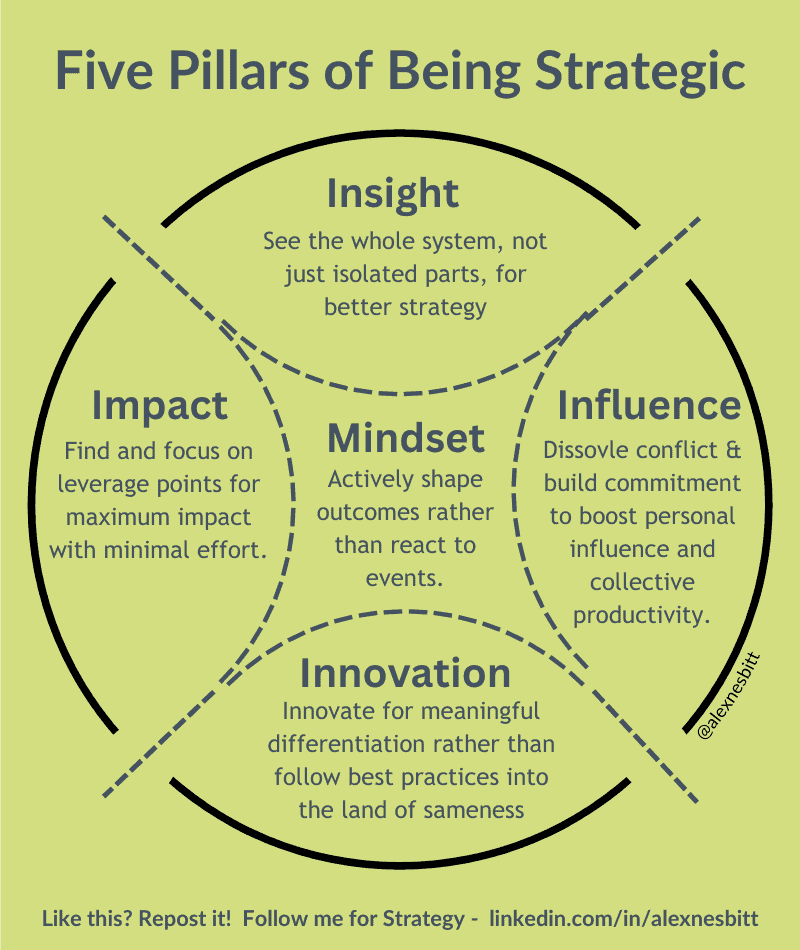
The first one I call the Enactive Mindset. The second is strategic insight, the third is strategic innovation, the fourth is strategic influence, and the fifth is strategic impact. These are five factors that I’d like you to focus on as you go down the path of mastering being strategic and enactive strategy.
I’m not going into these in much depth here, but the Enactive Mindset is essentially the idea that you happen to the world rather than being reactive. It’s a key shift from being a manager to being a leader.
Strategic Insight is about finding the critical things that matter—distinguishing the vital few leverage points from the many trivial ones.
Strategic Influence: Understand that influence, not control, is the real currency of leadership. And the more you can amplify your influence, the more impact you will have on this world.
Strategic Innovation is particularly focused on innovation in how things work, specifically how organizations can innovate in ways that drive more asset productivity.
When it comes to Strategic Impact, there are ways of approaching the way you go at things, the way you try to tackle projects, and the way you try to make work happen that are more effective than other ways.
To the extent that you can master these five pillars, you will be somebody who is seen as being more strategic. You will be seen as somebody who is being enactive.
And the payoff to those that master these five pillars can be tremendous in terms of added recognition, responsibility, and reward.
In concluding this edition of Luck Hacker, I want to talk a little bit more about the path to mastering this skill.
It’s important to understand that becoming proficient in this skill doesn’t happen overnight; it’s a gradual process that requires time and effort.
Think of it like compound interest, where small improvements add up over time.
For instance, if you improved by just one percent every day, by the end of the year, you’d be roughly 38 times more capable than you were at the start of the year.
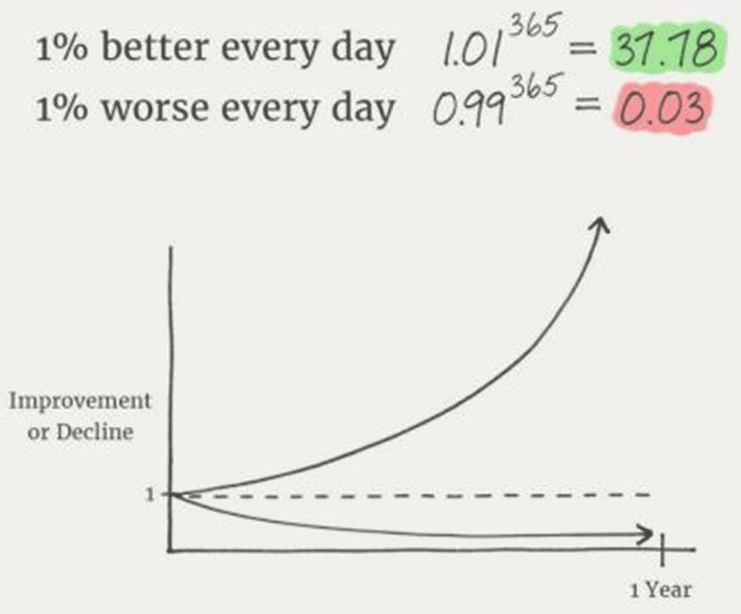
But if you fail to take action, the compounding effect won’t happen.
Developing this skill requires continuous effort; it can’t be done passively.
So, the question I pose to you is, will you put this aside as something interesting to revisit later? That’s a valid choice, but it means you’ll lag behind those investing in self-development and honing this skill.
Alternatively, you can take action now.
Choose to be enactive, get involved, and transition from a reactive mindset to an enactive one.
If you genuinely want to be more enactive and strategic, be prepared to put in the effort. Take control of your future and be the one who shapes it. Waiting only defers your progress and allows others to determine your path.
****************
If you want to learn more and are ready to invest in developing your strategic leadership, I built an online mentoring program for you called “Strategic Thinking for Advantage.” It’s a system for strategic thinking that applies to both strategy and tactics. It shows you how you can become more strategic.
If you want to level up your strategic capabilities, check it out at this link:
https://academy.alexnesbitt.com/strategic-thinking-for-advantage
****************
Until next time, I encourage you to be enactive, to be someone who actively shapes their world.
Happy Holidays.
Best,
Alex
Research Sources: Enactive Strategy; Zenger Folkman; DDI | Development Dimensions International
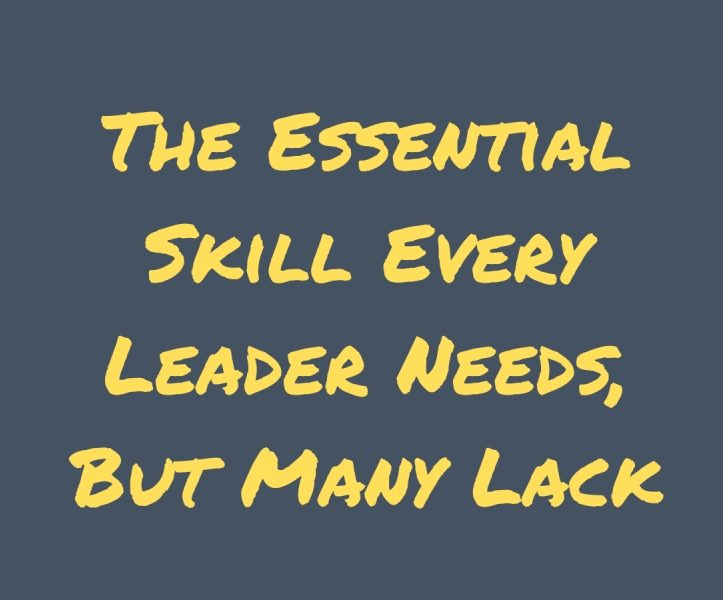
 The True Purpose of Strategy
The True Purpose of Strategy